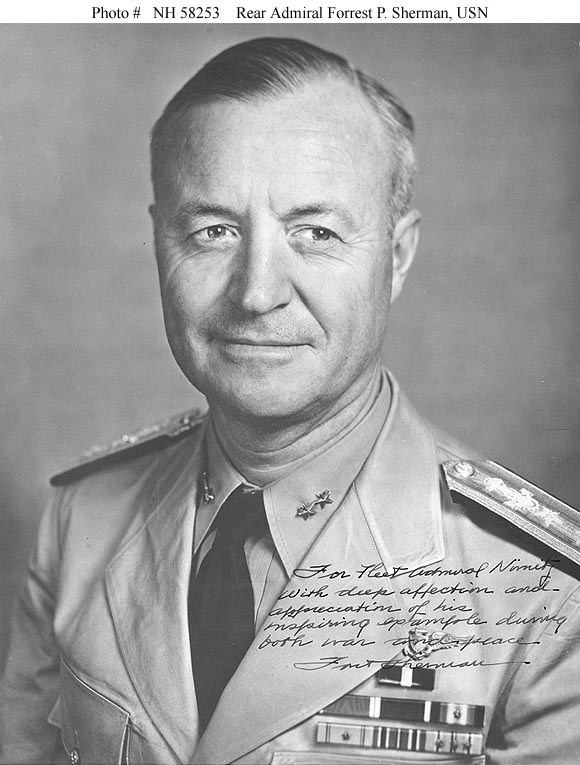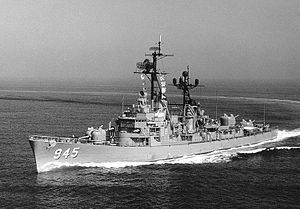Years of service 1917–1951 | Name Forrest Sherman Rank Admiral | |
 | ||
Birth name Forrest Percival Sherman Born October 30, 1896Merrimack, New Hampshire, U.S. ( 1896-10-30 ) Allegiance United States of America Commands held USS Barry (DD-248)Scouting Squadron 2Fighting Squadron 1USS Wasp (CV-7)Sixth Fleet Awards | ||
Uss forrest sherman ddg 98 click click boom
Forrest Percival Sherman (October 30, 1896 – July 22, 1951) was an admiral in the United States Navy and the youngest man to serve as Chief of Naval Operations until Admiral Elmo Zumwalt became Chief of Naval Operations in 1970. The Forrest Sherman class destroyer was named for him.
Contents
- Uss forrest sherman ddg 98 click click boom
- Uss forrest sherman departs naval station norfolk
- Early life and education
- Career
- Legacy
- Decorations and medals
- References

Uss forrest sherman departs naval station norfolk
Early life and education
Born in Merrimack, New Hampshire, Sherman was a member of the Naval Academy class of 1918, graduating in June 1917 due to America's entry into World War I. During and shortly after World War I, he served in European waters as an officer of the gunboat Nashville (PG-7) and destroyer Murray (DD-97). In 1919–21, Sherman was assigned to the battleship Utah (BB-31) and destroyers Reid (DD-292) and Barry (DD-248), serving as Commanding Officer of the latter.
Career
Following duty as Flag Lieutenant to Commander Control Force, Atlantic Fleet, he received flight training at NAS Pensacola, Florida. Designated a Naval Aviator in December 1922, Lieutenant Sherman was assigned to Fighting Squadron 2 (VF 2) until 1924, when he returned to Pensacola as an instructor. Study at the Naval War College was followed in 1927 by service in the aircraft carriers Lexington (CV-2) and Saratoga (CV-3). While in the latter ship, he commanded Scouting Squadron 2 and was Flag Secretary to Commander Aircraft Squadrons, Battle Fleet.
Promoted to the ranks of Lieutenant Commander in 1930 and Commander in 1937, during that decade Sherman served at the Naval Academy, commanded Fighting Squadron 1, had charge of the Aviation Ordnance Section of the Bureau of Ordnance, was Navigator of the aircraft carrier Ranger (CV-4), and had duty on a number of flag staffs. In 1941–42, he served with the Office of the Chief of Naval Operations and was a member of the Permanent Joint Board on Defense, Canada-United States.
Commander Forrest Sherman worked closely with then US Army Major Albert C. Wedemeyer author of the "Victory Plan of 1941", "the blueprint...for the mobilization of the United States Army for World War 2". Wedemeyer, while working in the War Plans Department, was commissioned to write the "Victory Plan by General George C. Marshall.
"The Victory Plan predicted the future organization for an army that did not yet exist, outlined combat missions for a war not yet declared, and computed war production requirements for industries that were still committed to peacetime manufacture." Captain Forrest Sherman's personal relationship with Major Albert Wedemeyer "ensured a community of planning effort between the two services and pointed to a future in which the services would acknowledge that mobilization planning was a joint responsibility that one service alone could not conduct adequately." (From "Writing the Victory Plan of 1941" by Charles E. Kirkpatrick)
In May 1942, after reaching the rank of Captain, Sherman took command of the carrier Wasp (CV-7), taking her through the first month of the Solomon Islands campaign.
After Wasp was sunk by a Japanese submarine on September 15, 1942, he was awarded the Navy Cross for his extraordinary heroism in command of the carrier during the opening days of the South Pacific operations. Sherman then became Chief of Staff to Commander Air Force, Pacific Fleet. In November 1943 Rear Admiral Sherman was assigned as Deputy Chief of Staff to the Pacific Fleet commander, Admiral Chester W. Nimitz. He held that position for the remainder of World War II, playing a critical role in planning the offensives that brought victory in the Pacific, and was present when Japan surrendered on September 2, 1945. Following a short tour as a carrier division commander, in December 1945 Vice Admiral Sherman became Deputy Chief of Naval Operations.
Sherman's next assignment, beginning in January 1948, was to command the Navy's operating forces in the Mediterranean Sea. He was recalled to Washington, D.C., at the end of October 1949 to become Chief of Naval Operations, with the rank of Admiral. During the next sixteen months, he helped the Navy recover from a period of intense political controversy (as in the so-called "Revolt of the Admirals"), and oversaw its responses to the twin challenges of a hot war in Korea and an intensifying cold war elsewhere in the world.
On July 22, 1951, while on a military and diplomatic trip to Europe, Admiral Forrest Sherman died in Naples, Italy, following a sudden series of heart attacks. He was buried at Arlington National Cemetery on July 27, 1951.
Legacy
The Forrest Sherman class destroyer was named in his honor, as were two destroyers: USS Forrest Sherman, DD931 and USS Forrest Sherman DDG-98. Also named in his honor was Sherman Island, Antarctica, Forrest Sherman Field, NAS Pensacola, home of the Blue Angels, and Forrest Sherman Field, Hospital Point, US Naval Academy. The US Department of Defense school in Naples, Italy was formerly called Forrest Sherman High School.
Decorations and medals
Source:
